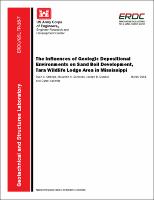Please use this identifier to cite or link to this item:
https://hdl.handle.net/11681/20310Full metadata record
| DC Field | Value | Language |
|---|---|---|
| dc.contributor.author | Strange, Ryan C. | - |
| dc.contributor.author | Corcoran, Maureen K. | - |
| dc.contributor.author | Dunbar, Joseph B. | - |
| dc.contributor.author | Schmitz, Darrel W. | - |
| dc.date.accessioned | 2016-10-28T21:07:43Z | - |
| dc.date.available | 2016-10-28T21:07:43Z | - |
| dc.date.issued | 2016 | - |
| dc.identifier.uri | http://hdl.handle.net/11681/20310 | - |
| dc.description.abstract | Abstract: A comprehensive study of the subsurface geology in the Tara Wildlife Lodge area in Mississippi was undertaken to identify seepage pathways that lead to sand boils. After the completion of soil borings, geophysical surveys, and cone penetrometer tests and the analysis of the boring logs and test results, the subsurface in the Tara Wildlife area was better characterized with the creation of cross sections and imagery. The cross sections and imagery based on the data helped researchers to better understand the geologic phenomena that were occurring and causing sand boils. Results suggest that the Tara Wildlife Lodge area in the Talla Bena Quadrangle is located on pervious point bar deposits consisting of cohesionless sands with little to no overburden resistance. | - |
| dc.publisher | United States. Army. Corps of Engineers. | - |
| dc.publisher | Engineer Research and Development Center (U.S.) | - |
| dc.publisher | Geotechnical and Structures Laboratory (U.S.) | - |
| dc.relation | http://acwc.sdp.sirsi.net/client/search/asset/1049088 | - |
| dc.relation.ispartofseries | ERDC/GSL ; TR-16-7 | - |
| dc.subject | Levees | - |
| dc.subject | Sand | - |
| dc.subject | Erosion | - |
| dc.subject | Seepage | - |
| dc.subject | Geophysical surveys | - |
| dc.subject | Geological cross sections | - |
| dc.subject | Penetrometers--Testing | - |
| dc.subject | Mississippi River | - |
| dc.title | The influence of geologic depositional environments on sand boil development, Tara Wildlife Lodge Area in Mississippi | - |
| Appears in Collections: | Technical Report | |
Files in This Item:
| File | Description | Size | Format | |
|---|---|---|---|---|
| ERDC-GSL TR-16-7.pdf | 16.51 MB | Adobe PDF |  View/Open |